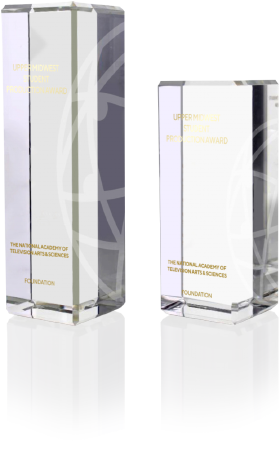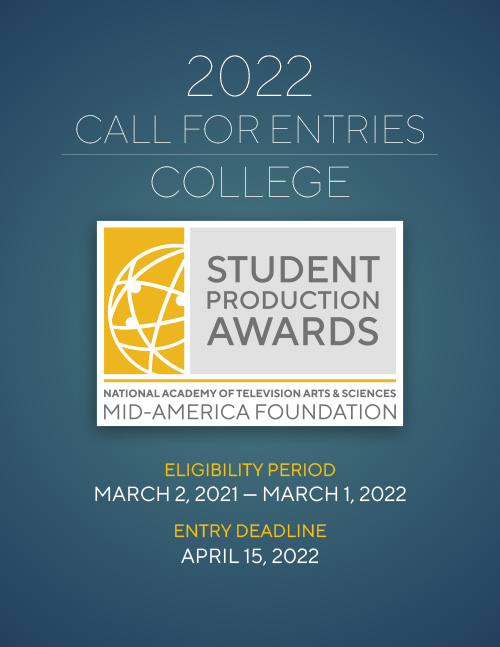STUDENT WINNERS ANNOUNCED
June 23, 2022
Student Pillars Presented at
Regional EMMY® AWARDS
Ceremony
Saturday, October 29, 2022
ELIGIBILITY PERIOD
March 2, 2021 — March 1, 2022
ENTRY DEADLINE
FRIDAY APRIL 22, 2022
THE NATIONAL ACADEMY OF TELEVISION ARTS & SCIENCES
NATAS is a professional service organization dedicated to the advancement of the arts and sciences of television and related media and the promotion of creative leadership for artistic, educational and technical achievements within the television industry, best known for the coveted Emmy® Award.
ELIGIBILITY AREA
All broadcast, cable, broadband, cable / community / government access and video content providers (not close circuit or venue specific) located within the following Designated Market Areas (DMAs):
- St. Louis
- Kansas City
- Little Rock
- Springfield (MO)
- St. Joseph
- Columbia/Jefferson City
- Joplin/Pittsburg
- Quincy/Hannibal/Keokuk
- Ottumwa/Kirksville
- Davenport/Rock Island/Moline
- Paducah/Cape Girardeau/Harrisburg
- Champaign/Springfield/Decatur
- Fort Smith/Fayetteville/Springdale/Rogers
- Jonesboro
- Monroe-Eldorado and Shreveport (LA)
FEES
HIGH SCHOOL
$25 per entry
May include up to 2 names per entry
COLLEGE
$35 per entry
May include up to 2 names per entry
Payment Options
PayPal Preferred. Checks will be accepted and must be received by April 18th. Please make checks payable to:
NATAS Mid-America
3655 Olive St.
St. Louis, MO 63108
Payment Deadline
All entries paid via PayPal must be paid in full by the deadline – deadline to receive checks for entries is April 18.
Mid-America Student Production Awards
STANDARD RULES AND REGULATIONS
- Projects conceived, produced and executed by students at a high school, university, college or technical/vocational school within the Chapter’s designated awards region are eligible for student award consideration.
- Returning students who previously worked as professionals are not eligible.
- No professional services may have been employed in the production of the entry.
- Faculty involvement can only be advisory.
- Entrants must be enrolled as a full-time student during the eligibility period.
- Students may enter work that was produced as a class assignment, extra-curricular assignment or in conjunction with their academic experience.
- Students who perform professional work may enter their work in the professional awards competition, provided they meet all eligibility requirements.
- No entry may be submitted to more than one Chapter’s awards.
- The entry does not need to have been broadcast, cablecast or webcast to be eligible.
- Entry videos must as they were originally submitted to their advisor. There may not be any edits to the originally completed video except for edits to bring the entry length within the specified category time limit. When editing for time, use only straight cuts with one second of black to denote where content has been removed.
- There is no limit to the number of entries a school may submit in each category.
- Pornographic, violent, defamatory or offensive material is not accepted. The interpretation of the Awards Committee is final and absolute.
- Ineligible entries may be disqualified during any phase of the competition.
- St. Louis
- Kansas City
- Little Rock
- Springfield (MO)
- St. Joseph
- Columbia/Jefferson City
- Joplin/Pittsburg
- Quincy/Hannibal/Keokuk
- Ottumwa/Kirksville
- Davenport/Rock Island/Moline
- Paducah/Cape Girardeau/Harrisburg
- Champaign/Springfield/Decatur
- Fort Smith/Fayetteville/Springdale/Rogers
- Jonesboro
- Monroe-Eldorado and Shreveport (LA)
Mid-America Student Production Awards
CATEGORIES
HIGH SCHOOL
COLLEGE
2022 CALL FOR ENTRIES
CALL FOR ENTRIES PDFs
Categories
HIGH SCHOOL
H-01 · Newscast
H-02 · News Report — Serious News
H-03 · News Report — Light News
H-04 · Multimedia Journalist (MMJ)
H-05 · Non-fiction — Short Form
H-06 · Non-fiction — Long Form
H-07 · Arts and Entertainment/Cultural Affairs
H-08 · Public Affairs/Community Service
H-09 · Public Service Announcement (PSA)
H-10 · Sports Story or Segment
H-11 · Sports Program
H-12 · Live Sporting Event/Game
H-13 · Editor
H-14 · Photographer
H-15 · Talent — News or Sports
H-16 · Writer
COLLEGE
C-01 · Newscast
C-02 · News Report — Serious News
C-03 · News Report — Light News
C-04 · Multimedia Journalist (MMJ)
C-05 · Non-fiction — Short Form
C-06 · Non-fiction — Long Form
C-07 · Arts and Entertainment/Cultural Affairs
C-08 · Magazine Program
C-09 · Sports Story or Segment
C-10 · Sports Program
C-11 · Animation/Graphics/Special Effects
C-12 · Talent — News or Sports
C-13 · Photographer
C-14 · Editor
C-15 · Writer
CONTACT
If you have any questions, contact us at:
618-444-9756 (cell / text)
maggie@emmymid-america.org
MID-AMERICA SCHEDULE
Eligibility Period
March 2, 2021 – March 1, 2022
ENTRY DEADLINE
April 22, 2022
scholarshipS
GRANT
Continuing Education Opportunity Grant C.E.O.G
Applications Deadline
April 29, 2022
Awards Store

Mid-America Student Production Awards
STANDARD RULES AND REGULATIONS
- Projects conceived, produced and executed by students at a high school, university, college or technical/vocational school within the Chapter’s designated awards region are eligible for student award consideration.
- Returning students who previously worked as professionals are not eligible.
- No professional services may have been employed in the production of the entry.
- Faculty involvement can only be advisory.
- Entrants must be enrolled as a full-time student during the eligibility period.
- Students may enter work that was produced as a class assignment, extra-curricular assignment or in conjunction with their academic experience.
- Students who perform professional work may enter their work in the professional awards competition, provided they meet all eligibility requirements.
- No entry may be submitted to more than one Chapter’s awards.
- The entry does not need to have been broadcast, cablecast or webcast to be eligible.
- Entry videos must as they were originally submitted to their advisor. There may not be any edits to the originally completed video except for edits to bring the entry length within the specified category time limit. When editing for time, use only straight cuts with one second of black to denote where content has been removed.
- There is no limit to the number of entries a school may submit in each category.
- Pornographic, violent, defamatory or offensive material is not accepted. The interpretation of the Awards Committee is final and absolute.
- Ineligible entries may be disqualified during any phase of the competition.
- St. Louis
- Kansas City
- Little Rock
- Springfield (MO)
- St. Joseph
- Columbia/Jefferson City
- Joplin/Pittsburg
- Quincy/Hannibal/Keokuk
- Ottumwa/Kirksville
- Davenport/Rock Island/Moline
- Paducah/Cape Girardeau/Harrisburg
- Champaign/Springfield/Decatur
- Fort Smith/Fayetteville/Springdale/Rogers
- Jonesboro
- Monroe-Eldorado and Shreveport (LA)
Mid-America STUDENT PRODUCTION Awards
CATEGORIES
HIGH SCHOOL
H-01 · Newscast
H-02 · News Report — Serious News
H-03 · News Report — Light News
H-04 · Multimedia Journalist (MMJ)
H-05 · Non-fiction — Short Form
H-06 · Non-fiction — Long Form
H-07 · Arts and Entertainment/Cultural Affairs
H-08 · Public Affairs/Community Service
H-09 · Public Service Announcement (PSA)
H-10 · Sports Story or Segment
H-11 · Sports Program
H-12 · Live Sporting Event/Game
H-13 · Editor
H-14 · Photographer
H-15 · Talent — News or Sports
H-16 · Writer
COLLEGE
C-01 · Newscast
C-02 · News Report — Serious News
C-03 · News Report — Light News
C-04 · Multimedia Journalist (MMJ)
C-05 · Non-fiction — Short Form
C-06 · Non-fiction — Long Form
C-07 · Arts and Entertainment/Cultural Affairs
C-08 · Magazine Program
C-09 · Sports Story or Segment
C-10 · Sports Program
C-11 · Animation/Graphics/Special Effects
C-12 · Talent — News or Sports
C-13 · Photographer
C-14 · Editor
C-15 · Writer
HIGH SCHOOL
COLLEGE
GLOSSARY OF TERMS
- Serving as an “overseer” of the content, determining the overall tone, structure, look, sound, and mission of the content.
- Making strategic editorial decisions that have a significant impact on the resulting content.
- Identifying interview subjects and shoot locations.
- Scheduling interviews, shoots, and edits.
- Writing and/or approving scripts.
- Formulating ideas for graphics/animations and working with designers through completion.
- Working with editors to assure the content meets expectations and overseeing necessary changes.
- For studio-based programs or content, the producer would generally fulfill much of the above and/or oversee control room decisions, timing, etc.

